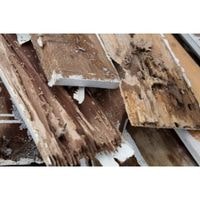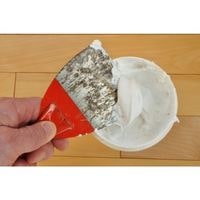How to fill large holes in rotted wood. As far as furniture goes, wood kind of takes a beating. No matter if it’s walls or tables, dressers or cabinets no furniture made from wood is immune to damage.
And this can be observed in many ways the most familiar probably being when a hole is created that could otherwise render the item useless.
But don’t worry. You can easily fix these kinds of things and some easy-to-find wood filler before painting over it for a brand new surface.
How to fill large holes in rotted wood

Wood fillers are used to fill holes in woodwork. All wood fillers are not created equal; different fillers are better for different situations.
The variety of woods used in woodworking projects and finishes and techniques used on the raw wood (such as painting, staining, or sanding) can affect your choice of filler material.
Repairing holes with polyester filler
Polyester filler is used to repair holes in everything from car bodies to wood-paneled walls. It’s almost the same concept as two-part epoxy, but the application is different.
A hardener (that isn’t necessarily toxic) follows a resin, which is applied with a brush over-scaled or rotting wood and allowed to dry for about 20 minutes.
This filler: Tends to sag if not supported properly during drying. Typically requires at least two coats before being completely covered and hardened.
Begins to harden in 15 minutes, though it generally takes 24 hours before the filler is fully cured and set into its final form.
Is best for rotten, deteriorated wood because of its ability to stabilize wood that otherwise might just crumble apart over time without support. Requires sanding and repainting if used on areas where paint/stain will be applied afterward.
The standard spackling paste

There are several key factors you should consider before purchasing spackling paste hoping to fix holes or dents in your walls, woods, trim, or baseboard.
The first factor is the compatibility of the spackling paste with the material it’s being applied on, which in this case is wood.
Next, the paste needs to be able to dry hard without the need for sanding between coats (or layers), so that paint can adhere well.
Some types of drywall for example require 3 coats of spackle for proper bonding to take place because of this. Very thick areas of damage may also require more than one application.
This is not true with all types however so if there is any doubt then it’s best to double-check with the manufacturer before commencing any such work!
Using Two-Part Epoxy
Epoxy is one of the best options for patching large holes (think windows, floorboards, woods, and sills).
One can use epoxy on moldings, baseboard (or trim), door frames, or any other part made from wood that has sustained some damage or if there are substantial gaps including old repairs.
In order to repair with epoxy, the individual must mix together both parts as though they were dough before applying them to their damaged area.
As soon as the two parts are mixed together, the epoxy can be applied and in many cases, it is recommended that you press it into place (i.e. kick around) or even shape it into place (if you’re using a hole saw for example).
You can then leave the material to dry almost immediately which is always faster than most people expect. After this initial drying period which usually takes no longer than 24 hours.
You’re ready to apply paint right away should you need to cover up your surface so it can either match your walls or look good all on its own.
Apply Acrylic caulk with silicone
Acrylic caulking is an appropriate choice of exterior wood filler to use for medium-sized holes in your home.
This type of caulk: Is moisture-resistant, so it will continue to stand firm after a period of time and resist weather buildup.
Is flexible and can move as the house itself shifts or otherwise moves over time. Stays solid and won’t crumble leaving ridges or cracks on interior or exterior surfaces.
Can be filled easier than ever with the help of a tube applicator that makes it easy to apply directly from one spot to another without needing to tape off unwanted areas first.
Using Cellulose fillers
Cellulose filler is designed for filling holes or cracks in the wood that you plan to finish with a stain or a topcoat. Cellulose is made from real wood fiber, won’t shrink when it dries, and sands flat and even.
It can be stained or painted so it looks just like real wood for finishing jobs like cabinets, trim work, ledges, mantels, or other unfinished wood.
Some types are also manufactured to require little time to dry, allowing the filler to set without requiring sanding overnight but keep in mind that the dried cellulose will still take several days to several weeks to completely cure before the paint can be applied over it.
Using Glue and Sawdust

Fill in the holes of rotted wood by preparing this method for at-home use. You will require wood glue or carpenter’s glue.
White sawdust which is similar to the kind of wood that you plan on covering, and an applicator (a spatula).
To intensify the sawdust along with the adhesive, you should combine them together with the help of a spatula and make sure to create it into a thick paste formation.
Next, you can simply spread this sawdust mixture over your damaged wooden surface and then wait until it has completely dried out before sanding down any rough surfaces.
How to fill large holes in rotted wood
Related Guides
